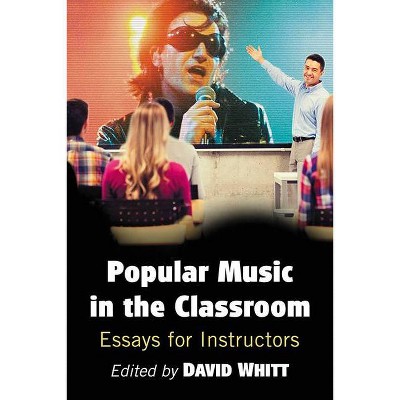The Economics of the Popular Music Industry - by C Byun (Hardcover)

Similar Products
Products of same category from the store
AllProduct info
<p/><br></br><p><b> Book Synopsis </b></p></br></br><p>This Palgrave Pivot uses modeling from microeconomic theory and industrial organization to demonstrate how consumers and producers have responded to major changes in the music industry.</p><p/><br></br><p><b> From the Back Cover </b></p></br></br><p>This Palgrave Pivot uses modeling from microeconomic theory and industrial organization to demonstrate how consumers and producers have responded to major changes in the music industry. Byun examines the important role of technology in changing its structure, particularly as new methods of creating and accessing music prove to be a double-edged sword for creators and producers. An underlying theme in the project is the question of how the business of music affects creativity, and how artists continue to produce creative output in the face of business pressures, the erosion of copyright enforcement, and rampant online piracy. In addition to being a useful resource for economists interested in the music industry, this approachable Pivot is also ideal for business and music majors studying the effect of technology on their chosen fields.</p><p/><br></br><p><b> Review Quotes </b></p></br></br><br><p>Review 1: <br/><br/>Vanessa Rogers <br/>Assistant Professor of Music History<br/>Rhodes College<br/>By using modelling from Microeconomic theory and Industrial Organization, the author proposes to analyse several aspects of the music industry from an economic standpoint. The author seeks to establish that musical creativity in (popular?) music is affected by economic considerations, and that recent developments in technology have changed the structure of the modern music industry.<br/>The author proposes four chapters. The first is an overview of the basic economic aspects of the music industry, including an introduction to Microeconomic theory and Industrial Organization. The author's central argument regarding the importance of changes in technology is also presented in this chapter. <br/>The second chapter outlines the oligopolic market structures found in the structures of the modern record company. The hegemony of the company 'brand' and high start-up costs are found to be restrictive to artists; in addition, the current means of production and distribution of music are also described as monopolies. Emphasis is given to new copyright issues, one of which is the problem of music reproduction. The chapter focuses on providing the basics of music industry as a business. It also elaborates further upon the main argument (the importance of technology), and for the first time mentions the second argument regarding artist creativity as an aspect of music production under examination.<br/>The third section of the book examines consumer behaviour by using Microeconomic theory. Consumer preferences are taken into account when considering the market for music, and consumer theory is applied to the decisions made by consumers when making a purchase. <br/>The fourth chapter focuses on the substantial role of technology in the business of music, and on recent technological advances which impact the music industry, including home studios, personal computers, self-built websites, digital downloads, and the advent of YouTube and social media. <br/>***<br/>This book will clearly fill a gap in the current offerings in studies of economics and the music industry, and deserves to be published. The author's proposal outlines a text which would provide an engaging and intellectual overview of economics, especially for students learning about economics for the first time. The two central arguments that technology is instrumental to changes in the industry, and that musical creativity is affected by these changes are particularly strong.<br/>The proposal as it stands, however, ought to be fleshed out further in order to address the following concerns below: 1) scope, and 2) clarity of argument.<br/>Scope: The author does not make clear the scope of this study. The author states that the project will 'provide a general overview of the music industry from an economics perspective'. Will this book concentrate solely on the American modern popular music industry, or will it include discussion of the global music market? Which genres of music will be examined (rock, pop, r&b, etc.)? The author never explicitly says that they will concentrate on 'pop' music production (they mention an example using 'pop songs' in chapter three), so can we assume that they will also look at classical, country, and other types of music that are also part of the general 'music industry'? <br/>Which parts of the 'music industry', specifically, will be examined? 'Economic aspects of the industry' certainly includes more than just the creation, production, and distribution of recordings, but also musicians' incomes, the wages of sound engineers and promoters and other related personnel, 'swag' and merchandise sales, other related income streams (such as P. Diddy's clothing line, for example), music videos, television and other commercial music, ticket prices, broadcasting, and copyright issues, to name just a few.<br/>Will the author examine historical aspects of the music industry? The 'music industry', broadly defined, stretches back for centuries in Western history, and includes music printing, the development and sale of instruments and music tutorials, and so on (for example, see the book Pop Song Piracy: Disobedient Music Distribution since 1929, Univ. of Chicago Press, 2011). Can we look at earlier musical markets using Microeconomic theory and Industrial Organization? If not, where did the modern music industry as we know it begin? The author, in their description of the fourth chapter, mentions 'the old model of listening to music on a stereo' but doesn't discuss whether or not they will compare and contrast earlier modes of listening and consuming music with the present ones. This should be clarified. <br/>Argument: The author lists as a key benefit of this project the examination of 'the complex relationship between artistic creativity and the business of music'. This is a unique and interesting angle which would indeed set this study apart. But according to the chapter outline, artist creativity is mentioned only briefly in the second chapter.<br/>I believe that the proposal (and book) would be strengthened by concentrating on this theme throughout the entire book, not just one chapter, in the way that the author discusses technology in each chapter of the proposal.<br/>In terms of structure of the study, will the author utilize specific case studies in order to illustrate their points? If so, which ones?<br/>Most Music Industry classes are taught from a practical and entrepreneurial perspective, which is why Passman's All You Need to Know About the Music Business is such a popular text. The inclusion of specific case studies in this author's project, then, will not only illustrate the economic theories under discussion, but will also provide examples of practical problems and solutions that would be helpful to students in real-life situations. <br/>The music business is a fast-changing industry, and the shelf-life of most books about the music industry is only a few years. However, this author's proposed book would have a longer shelf-life than most, since it teaches economic concepts, and not necessarily up-to-the minute business strategies.<br/>In fact, these introductory economic concepts (Microeconomic theory, Industrial Organization, imperfect substitutes, etc.) are what make this book stand apart from other music industry books. It is a truly original idea, and I believe that there is a need for this study in today's market.<br/>For these reasons, the book would be of most interest to those teaching undergraduate students. In particular, Economics students and Music Business students would benefit the most from the book. Most undergraduate liberal arts students in the United States are required to take an Economics 101 course (note: there are nearly a thousand liberal arts colleges in the United States), and such a course might have the music industry as a theme such a topical, timely topic would certainly engage today's college students. The shorter nature of the Palgrave Pivot initiative works in this study's favour: an instructor could use it as a central text in a class on the topic of 'Economics of the Music Industry', or utilize it as one of several texts should they want to spend only a section of their course on the economics of the music business.<br/>The bibliography of the competing texts listed by the author is very good. The author might also want to take a look at academic music texts such as Pop Idols and Pirates: Mechanisms of Consumption and the Global Circulation of Popular Music (Burlington, VT: Ashgate, 2008). Keith Negus's Music Genres and Corporate Cultures (Routledge, 1999) although a much older work also mentions artist creativity in terms of economics. I would have been interested to see how this author's proposed text differs from another Palgrave offering, Michael Jones's The Music Industries: From Conception to Consumption (Palgrave Macmillan, 2012).<br/>There is one grammatical error in the proposal, where under benefits the author writes that 'the role of technology cannot be understated', when I am sure that they mean 'overstated'.<br/><br/><br/>Review 2: <br/><br/>Patrick Waelbroeck<br/>Associate professor<br/>Department of economics and social sciences<br/>Telecom ParisTech<br/><br/>1. The project is mostly theoretical. It would be a great addition to also have a discussion of empirical results related to theoretical arguments.<br/>2. The project is too vague when it comes to digital music. How is it changing the way firms produce and distribute music? How digital music changes the way consumers listen to music? By the way, there are many journal articles and book chapters on this topic and it would be useful to have a list of references and a sense on how the project improves on existing references.<br/>3. The author does not address the role of collecting societies and how they are impacted by digital music.<br/>4. Ideas and arguments in each chapter are too vague and need to be better outlined.<br/><br/>Recommendation: Borderline accept if the author convincingly addresses those issues.<br/></p>"<br><p/><br></br><p><b> About the Author </b></p></br></br><p>Chong Hyun Christie Byun is Associate Professor of Economics at Wabash College, USA. She teaches courses on statistics, econometrics, environmental economics, and the economics of the financial crisis. She is an avid music listener and is interested in applying economic theory to study the changes in the music industry.</p>
Price History
Price Archive shows prices from various stores, lets you see history and find the cheapest. There is no actual sale on the website. For all support, inquiry and suggestion messagescommunication@pricearchive.us




















